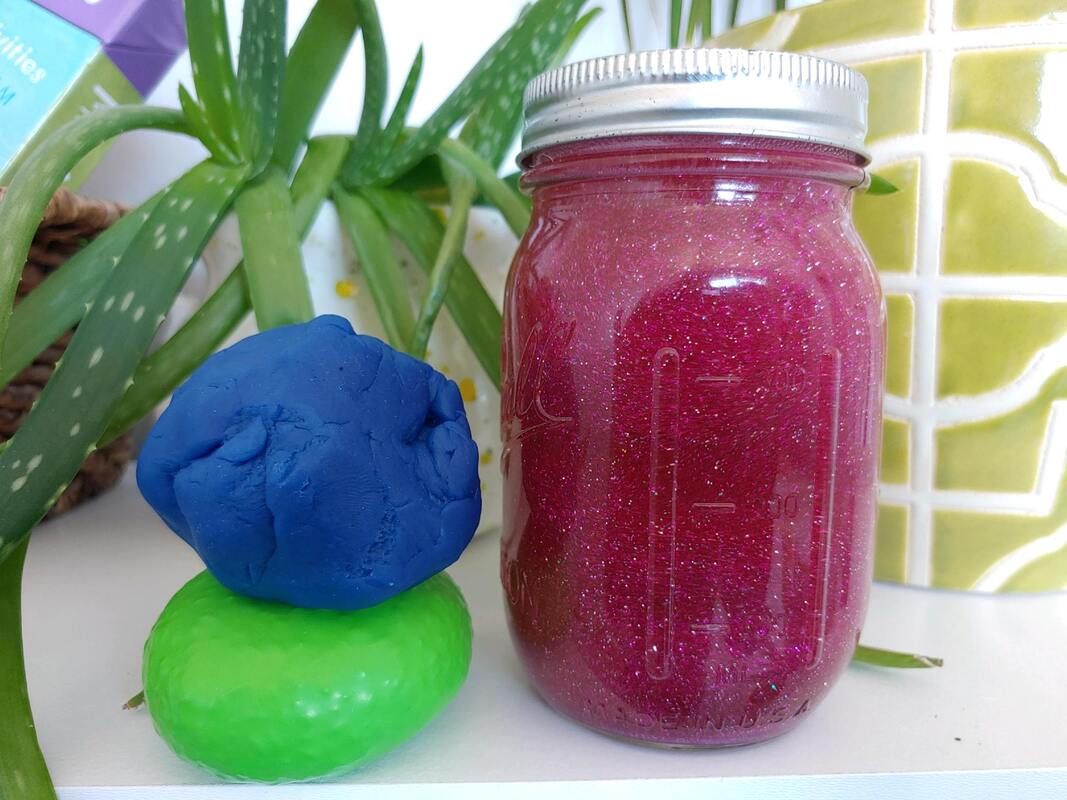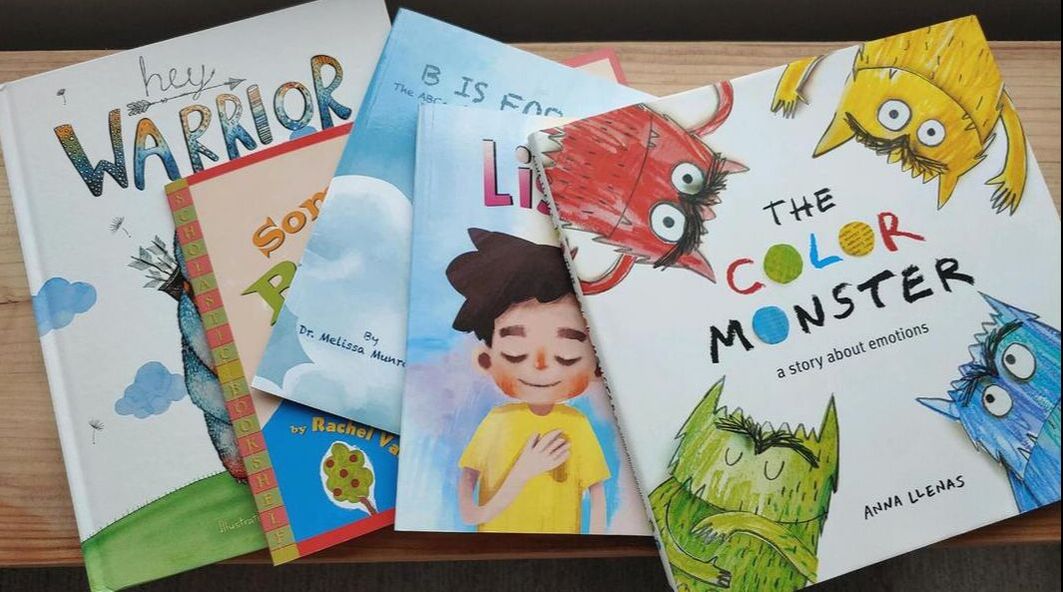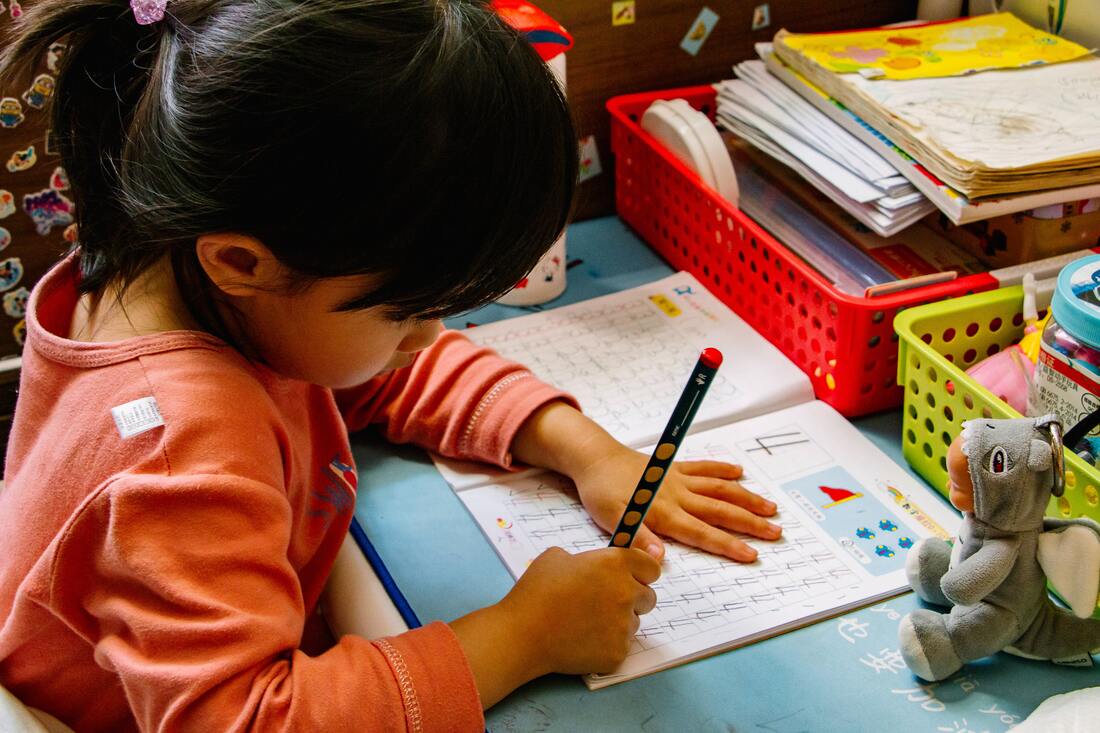|
Oh the things I have made in my office for regulation! Okay, in all honesty it hasn’t always been...the cleanest of things. Have I been out of my window of tolerance? Yes. Have I also learned some tips and tricks to make these things a bit neater? Also yes. Do kids always have fun? Most definitely!
Here is a list of the things I like to make with young people for regulation: Calm Down Jars These are the beautiful jars with swirly glitter that gets all excited when you shake it. They are amazing for mindfulness and are oh so soothing to look at. If you have the book Moody Cow Meditates they would call it a “Moody Cow Mind Jar”. The book talks about the glitter swirling around as upset thoughts and as we watch the glitter settle our thoughts settle too. Katie from the blog Preschool Inspiration goes over 6 ways to make these jars on her blog HERE! My favorite tips are VOSS water bottles seem to be the best for being plastic and a smooth exterior (some water bottles can be pretty bumpy). You can also super glue the lid on if you are worried that the top may come off. Also, the glitter will get everywhere. Have a lot of paper towels. I like to use warm water to help mix with the glue and it usually with settle a lot slower the fist couple of times you shake it and get quicker/less thick later on. Want to use a more environmentally friendly form of glitter? Check out Bio-Glitter! Play Dough My favorite part of Play Therapy trainings are the trainings that put the mini playdough containers on the tables as an invitation to play. It is just the best. It make sense that young people also love to regulate emotions and feel in control by squishing, squeezing, rolling and creating! One of the hardest things about making playdough in office is the cooking aspect. This recipe HERE is great. You need a mixing bowl and the only measuring materials you will need is the one cup and one tablespoon. You also will need flour, salt, cream of tartar, oil, and liquid food coloring. For the boiling water make sure you have a glass measuring cup and pop it in the microwave. You may need some extra thought and prep of how to get to the microwave and back, which might require permissions about a break room, parking the child in the waiting room with their parent, or a number of different other options. With creativity it can be done. Then you mix, color, and play! For holding you can put it in a plastic bag or the plastic disposable condiment containers you can buy at the store in the disposable Tupperware aisle. Then, the child can take the playdough home and regulates away! Stress Balls Or as I call them, balloons filled with rice, beans, or sand. Or nearly anything else like that. The cool thing about offering different materials is that you can get a different sensory experience from each. Kids love these things and over the course of therapy I might make many, many, many stress balls with one child. For this activity you need your “filler” - which is rice, beans, sand, etc., a funnel, and some balloons! I like to ask children if they want to be the “holder” or the “pourer”. The holder sounds pretty boring so they most likely will want to be the pourer. This is good news because if you are the “holder” you get to make sure the child stops putting the filler in the funnel before it overflows all over the floor and carpet. Ask me how I know. After the balloon gets good and full you tie it up and there you have your stress ball. Some of my best tips for this is double ballooning. Once you tie up the end cut the bottom off a second balloon. Putting it over the tie of the first balloon creates a second layer of balloon goodness. This will prevent the stress ball (more than just one layer) from breaking and spilling all over the inside of the car, the dining room, or their bedroom. Again, ask me how I know. The last tip with this is informed consent. Let the parent know about the activity, what is inside, and that it miiiiight come open. For this reason I have gravitated more towards rice and beans (easier to clean up) than sand (very hard to clean up). I Spy Jars These are so fun but do take some prep work on your part. For these jars I have dyed rice. That might sound super complicated - there are instructions for how to do it with kool aid HERE! The bonus is it smells good and I have done the mixing part over a client cancellation hour. The drying part takes a bit longer so if you are doing it at the office you need to make sure you have somewhere to put it. To make the jars you could use water bottles (with more rice) but I saved glass spice jars to make the I Spy Jars with. Less rice, smaller to transport, all positives. For this activity you have the child pick what color of rice they want in their jar. You can make this into a traditional I Spy, but I like to use a calming word for the jars. For this you also need letter beads, like these HERE. The child picks a calming word or affirmation, selects the needed letters and pops them in the jar. THEN they need to find all the letters, in order, to complete the hunt! Oh, and they are also reminded of their calming word in an effort to shift cognitions. Fantastic bonus! So there you have it, my top 4 calming crafts I love to make in my office! My one last tip is that there are a bit of odd materials you may need for these activities that you may not want in your general play stash. Flour, beans, and definitely food coloring. I have a little bin that I keep up higher with all of these materials. Currently I have them stored in a stockroom and out of my office. Now what about you? What sorts of regulation crafts are your favorite? Let me know below! Looking for more resources for regulation? Check out my training on Keep Calm and Regulate On: Play Therapy and the Neuroscience of Emotional Regulation!
4 Comments
Being a Cognitive Behavioral Play Therapist I truly believe that shifting the way we think about a situation is life changing. If we can shift the way we think our feelings (and behaviors) will follow the lead. This means the way we think about things is the key to feeling better, having more connected relationships, and behaviors that we can feel confident about.
Calming affirmations are specific phrases you can generate with a child or teen to help them gain control over their thoughts and regulate their emotions. It is usually positive or empowering in nature and is strengthened through practice. Sometimes you need to be a detective with the young people you work with and identify together what are the situations that come up the most often that they are upset by and what they were thinking. This could be with sand tray, puppet shows, drawings, or miniature role play. The ways that we can reach these themes through play are many! Now, once you have the common themes and thoughts that lead to the distress (likely rooted in their core beliefs about themselves and the world) you can get really good and developing the specific statements that will be the most impactful in the moment for regulation. My top 3 favorite are below: I am safe. At the end of the day nervous system dysregulation is all about safety. If our amygdala thinks something is threatening our life, like going to seriously injure or kill us, it will send us into the fight/flight response, which is all about safety. AND our amygdala will also send is into this response because of things it thinks are dangerous, not just things that are actually dangerous. Like that algebra test, having to get off video games, or when our friends don't invite us out to play. At the end of the day we need to remind ourselves that we are safe. I have choices. When we are anxious or angry sometimes we feel trapped. Like there is no way out of this thing that is in front of us. But, when we are using more of the regulated critical thinking parts of our brain we know this isn’t true. We know that there are choices, although sometimes not ideal ones. Even when that choice is what we tell ourselves and what we do with our own bodies. I am loved. One of the biggest threats to us can be a social threat. The fear of abandonment and rejection. Sometimes when one person can be unkind or rejecting of us it feels like ALL people in our lives feel that way. It’s just simply not true and when we check the facts there are so many people that care about us and love us. Once you have the most important phrases that young people need to tell themselves, getting them to remember and use these statements is another story. And part of that story? A lot of forgetting. And I get it, it’s hard if you haven’t practiced or don’t have a visual reminder. Heck - change in generally is really hard, even for adults with fully formed prefrontal cortexes. You as the therapist have to get VERY creative for how to help young people retain and remember the statement. Sometimes it is art, other times it is engaging a parent for help, or a visual prompt. My favorite for teens? Writing it on the mirror with a dry erase marker and rehearsing it before starting the day. I wanted to share this FREE download of 15 of calming affirmations. They are easy to print out (either you or your client) and small enough to fold up, tape to a notebook, put up on the wall or mirror, or fold in a pocket. Make sure you grab your copy HERE to help the young people you work with have another tool in their toolbox for calming self statements! Looking for more resources for regulation? Check out my training on Keep Calm and Regulate On: Play Therapy and the Neuroscience of Emotional Regulation! I love books SO MUCH! But they are not just for me...the young people I work with also think they are pretty neat too.
I talk about my love of books and why using books in Play Therapy, or Bibliotherapy, is so essential when working with kids HERE. I also have a free download of 70 Books to use with young people for emotional regulation work. Check out the download HERE! I wanted to highlight the top 5 books I use for emotional regulation: The Color Monster by Anna Llenas This one is by far one of the most popular, and respectful, books about all the different big feelings that we can have. Our main character meets “The Color Monster” who is all tangled up in emotions. She helps the monster untangle all of his emotions and he ends up feeling much better. Check out my favorite activity with this book and a free download HERE! You can also check out the book HERE! Listening to My Body by Gabbi Garcia This book is fantastic for going beyond feelings to tie feelings to sensations in our bodies. It helps with self reflection, mindfulness, and regulation and also has self reflection activities! Thinking about picking up a copy? Get one HERE! Gabbi also has a FREE activity guide with multiple activities that go with the book on her webpage HERE! Sometimes I’m Bombaloo by Rachel Vail Here we meet Katie Honors who has some pretty big feelings. Bombaloo feelings to be exact. These feelings are hard and scary but she is able to figure out what to do to feel like herself again. One of the things I really like about this book is it features a female identified character having big angry feelings. It normalizes for girls that they are not the only ones to have tantrums and outbursts. I also love that it doesn’t name the feeling - bombaloo can be whatever they like. Grab your copy HERE! Hey Warrior! I have so many favorites books for emotional regulation - but for teaching the neuroscience behind regulation this one takes the cake! It is the most expensive but honestly so worth it. It takes young people through the science behind the sympathetic nervous system response, normalizes it, and gives you the foundation for all other regulation work! You can check it out HERE! They miiiight also have a plushie Amygdala that I also just miiiight have in my Playroom. If you are so filled with jealousy and need one get yours HERE! B is for Breathe by Dr. Melissa Munro Boyd This concept is really fun! We get taken through the alphabet and for each letter we learn a new coping skill! It is definitely a great way to get the gears of the children we work with turning to identify what skills they like, don’t like, and need to do more of! Oh and lots of opportunity for practice! Check it out HERE! And that’s a wrap! Now, if you can’t get enough of books (like me) check out the free download of 70 books for emotional regulation HERE! What are your favorite books for regulation? Let me know in the comments below! Looking for more resources for regulation? Check out my training on Keep Calm and Regulate On: Play Therapy and the Neuroscience of Emotional Regulation! I would say that nearly all of the young people that walk in our door have big feelings. You know, tantrums, outbursts, frequent worry, panic at separation, loads of crying, times of feeling sad, worries that keep them from doing the things they love, pain about something tough that is happening in the past, currently happening, or will be happening. Yea, those big feelings.
I have yet to meet one child who didn’t have dysregulated emotions. And with that often comes shame. Feeling like they are somehow wrong or bad for having big feelings. Like it is bad to be angry. Weak to be sad or anxious. Shameful to not be "in control". AND none of these are true. The truth is these emotions, all of them, are a part of normal human experience. Normalizing this is essential for helping children work through these feelings. I wanted to share one of my favorite ways to talk about and normalizing having these big emotional reactions. It usually goes something like this: Feelings are not good or bad. They are our bodies way of telling us what is happening in the world around us and our bodies compass to help us decide what to do next. Feelings are something we all (including me) have every day, multiple times per day. I also will rope parents into the discussion and ask parents if they have been sad, happy, mad, or worried today - even just a little big. Spoiler alert - the answer is always YES! Not the big giant feelings all the time, but little tiny ups and downs with some medium and large feelings thrown in the mix. The next piece to know is that feelings are either comfortable or uncomfortable. The comfortable feelings let us know that we like (or are at least okay with) what is happening and want more of that thing in our environment. The uncomfortable feelings let us know that we don’t like what is happening around us or it is unsafe. It lets us know that we would like something to be different, or in cases of safety we need something different to survive. Are you with me so far? Good. So next, all behavior is purposeful and a way to either stay with those comfortable feelings or to get back to comfortable (or safe) feelings/circumstances. After we have that down, we shift to behavior. We now know that all behavior is purposeful and to help us get back to a safe/comfortable state. Well…. Choices or behaviors can be helpful or unhelpful. While we understand what a bummer it is to have to stop playing a video game, and thinking at some level that yelling loudly how we need to finish this level and how unfair it is that we have to quit is an attempt to keep playing the game (comfortable), the behavior is pretty unhelpful for not only the young person but everyone around them. Our job as therapists then becomes how can we help young people have insight into their emotions, warning signs, and triggers and give them the tools to return to comfortable states. Sometimes that might look like working on assertiveness and instead of yelling asking. Sometimes that might look like radical acceptance and using other things to regulate like sharing feelings, using deep breaths, or finding something else enjoyable to engage in. I often find that normalizing feelings and taking the shame out of them, and the behavior that follows is the way to start! How do you normalize feelings with clients? Tell us more in a comment below! Okay...well what we are really talking about is regulating the nervous system to get back to a ventral vagal state and out of our fight/flight response (sympathetic nervous system) or a shutdown state (parasympathetic nervous system) in a way where nobody knows we are trying to regulate our nervous system state.
Wheew. That is a mouthful and usually a bit more than our young people can digest in one sitting. So - covert calming is a little easier way to describe the activities and strategies we might use to get back to a state we feel in control of our emotions and thoughts and connected to ourselves that doesn’t draw attention to the fact we are trying to calm. BUT if that other stuff is totally your jam and you want to dive in deeper - that is all part of Dr. Stephen Porges’s Polyvagal Theory. I like to call Deb Dana the “translator” of the Polyvagal Theory from super deep and dense neuroscience to still heavily grounded in neuroscience but in a way that clinicians (as opposed to researchers) can understand and easily apply to client work. Her books like this one HERE is definitely my favorite. If you just want to dip your toe in check out this overview by Justin Sunseri HERE. He also has the Stuck Not Broken podcast which is absolutely fantastic. Okay, now back to covert calming. Calming skills and regulation skills are...complicated. At the end of the day I believe nearly 100% of the work we do with young people is to help them regulate their nervous system state. This can be done So. Many. Ways. Some theories like Cognitive Behavioral Play Therapy have regulation skills teaching as a core part of the theory. Other theories like Child Centered Play Therapy help the child regulate their nervous system in other ways, such as holding safe space and the relationship as the guiding factor. THEN there are those young people you work with that you could teach one zillion skills to and they refuse to use them. No thanks. Not interested. Deep breathing doesn’t work. OR there are the young people where you teach a zillion skills to and they find something completely and totally different to use to regulate. They might say something like “oh ya, those don’t work, I just do this AMAZING thing instead”. Usually with a straight face and a nonchalant voice. And then you burst out with excitement and your happy dance because young people are just so darn resilient! So, having said that not all kids need a tool box of skills you teach them to regulate outside of your office, but some do! For those kids one of the biggest barriers I have found to using skills are embarrassment and shame. For those kids I usually talk about “covert calming”. We get really curious and brainstorm what sorts of things they can do at their desk, in the halls, at dance practice, cub scouts (you get the picture) to regulate where nobody on the outside could tell they are doing it. Here are some of the ways I have found that work with young people: Deep breathing Deep breaths are my favorite way to teach regulating the nervous system. There are so many cool ways and games that you can use to teach deep breathing! AND the best thing about it is slowed heart rate actually changes your nervous system state because it signals to the body that the threat is gone. I always tell my clients that the cool news about deep breathing is everyone is doing it 24/7 so it definitely won’t be out of the norm if you, you know, continue to breathe. And because you have to you can yield it as a superpower. I will often engage in deep breaths as I talk about this topic and then at the end ask the client if they knew I was intentionally deep breathing. We can then practice in session and guess when we are being intentional vs. not. Going to the bathroom Well...not actually going to the bathroom, unless you need to and in that case - listen to your body! For some young people this may not be an option due to anxiety about asking to leave a situation (like class, a friends bedroom, a movie, etc.). BUT if they are able going to the bathroom and leaving the environment may make it easier to regulate. Sometimes being out of the environment will help their bodies begin to regulate easier. In the bathroom you can do things that you may have done anyway but just a little different. You can wash your hands with cold water in an attempt to calm. You can stop at the drinking fountain (if at school) to get a drink and some exercise/movement walking to and from the bathroom. When we are in a flight response (typically associated with anxiety) sometimes just walking can help discharge some of that energy. 5 Senses This one only requires minor movement and can be done nearly everywhere. With this one you (in your head) list out or engage in action for the following: 5 things you see 4 things you hear 3 things you touch (actually touching if possible) 2 things you smell (just noticing differences or smelling different things if possible) 1 thing you taste (can take a sip of something, put in gum, or just notice) Even if all are not able to be achieved even using some of our senses can ground us in the here and now! Toe tapping The Butterfly Hug* is something we often teach clients to help them soothe. If you are not familiar read more about it HERE! The downside to this is if a young person is tapping on their shoulders (like a self hug) their friends are sure to know about it! I usually suggest going down to the knees under the desk OR alternating tapping toes softly or scrunching toes in the shoes. I also like to add a safety statement like “I am safe” where one word is said with each tap! Visualizations Any visualizations are great for covert calming. It is only limited by your imagination! Some of my favorites are visualizing a favorite memory, a calm peaceful place, something they look forward to or containment. For containment I love to use a rocket ship metaphor where we are loading thoughts and feelings that don’t feel good for us in the moment into the rocket ship and blasting them off to outer space! What are your favorite ways to teach clients to “covertly calm”? Drop your favorites in the comments below! Looking for more resources for regulation? Check out my training on Keep Calm and Regulate On: Play Therapy and the Neuroscience of Emotional Regulation! *The Butterfly Hug was developed for use within EMDR (Eye Movement Desensitization and Reprocessing) by EMDR trained clinicians. I always like to give informed consent when I talk about the Butterfly Hug or Toe Tapping to clinicians who are not trained in EMDR to make sure they have some training in the mechanisms behind Bilateral Stimulation (BLS) and know the risks, which include (although very small) that a client could go into “reprocessing” with BLS and could become flooded or more anxious. Practicing in the office is essential. |
Hi, there!I'm Ann Meehan, an LPCC, Loading... Archives
July 2024
Categories
All
|
Privacy Policies | Terms of Use | Disclaimer
Contact
[email protected] | Copyright Meehan Mental Health Services 2022
Contact
[email protected] | Copyright Meehan Mental Health Services 2022









